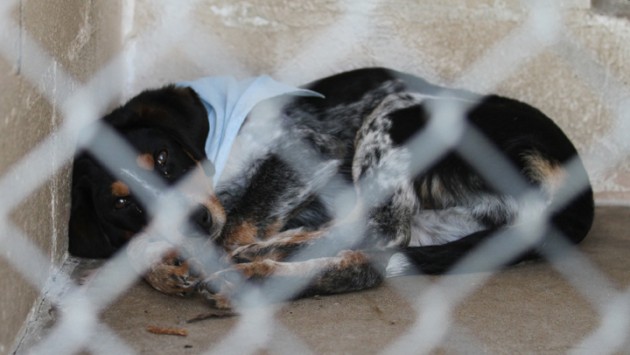
Matt Hellman | Lariat Photo Editor

Matt Hellman | Lariat Photo Editor
By Rob Bradfield
Staff Writer
No one adopting a puppy expects it to die after two weeks, but that is exactly what happened to several Baylor students.
Horseshoe Bay sophomore Lesley Lowry adopted a 6-month-old lab mix from the Humane Society of Central Texas at the beginning of the fall 2011 semester. Soon after she got it home, the dog became lethargic and began finding places to cower.
Several days later the dog was very clearly sick. It’s nose was dry, oozing mucus and the dog was having trouble eating.
According to veterinarians, Lowry’s dog was suffering from canine distemper — a highly contagious disease that can be fatal to unvaccinated dogs.
Lowry’s story is not an isolated incident. According to Dr. LuAnn Ervin, owner of the Texas Animal Medical Center, the Waco area has been in the grip of a canine distemper outbreak for nearly a year. Symptoms of distemper have been seen in dogs from across the area, and of different age groups.
The Texas Animal Medical Center normally sees no more than two or three cases each year, but last year’s total neared 30.
This year Ervin has already treated six dogs with symptoms of distemper, and as the weather gets warmer and more humid she expects to see more.
“It’s a viral infection, so the disease can spread like wildfire,” Ervin said.
Canine distemper is an airborne disease and can be transmitted between dogs very easily through contact or simply sharing space.
Symptoms include fever, diarrhea, difficulty breathing, lethargy, dry nose, mucus from the eyes and nostrils, and jaw spasms called “chewing-gum fits.” Treatments are available. Lowry spent nearly $400 on them, but there are limits to what veterinarians can do.
The best way to treat a dog with distemper, according to Kristen Dodson of the Hewitt Veterinary Hospital, is to make sure it doesn’t get it in the first place.
“I’d really stress that everybody gets their pets vaccinated,” Dodson said.
According to Ervin, the mortality rate for young dogs can be as high as 90 percent.
While puppies are the most likely to contract the disease, sick or old dogs are also at risk.
The best way to ensure containment is to isolate any new dogs for a short period before taking them out in public, and making sure all dogs are vaccinated.
“Everybody wants to see the new puppy, but it would be best not to take them out before getting them two or three vaccines,” Ervin said.
According to Gina Ford, Humane Society director, it’s standard procedure for shelters to vaccinate. However, vaccines also won’t work on animals that have already contracted the disease.
Since it can take between two and three weeks for dogs to start showing symptoms, dogs can pass through shelters without anyone knowing they’re sick.
“We would never knowingly send out an animal with distemper,” Ford said. “That’s cruel for the animal as well as the adopter.”
Although the Humane Society vaccinates every dog for distemper, due to the volume of dogs it gets each week it can sometimes take several days for a dog to receive all the required vaccines.
During an outbreak, even a short exposure can be enough for an unvaccinated dog to contract the disease.
The Humane Society is working to curb the number of cases and has changed its vaccination policy in response.
“We will be vaccinating all animals, starting April first, on immediate intake,” Ford said.
For Lowry, this all came too late. Veterinarians had to euthanize her dog when it became apparent that it wasn’t improving.
The Humane Society offered to give her another dog free of charge, but Lowry said she won’t be getting a new dog any time soon.






